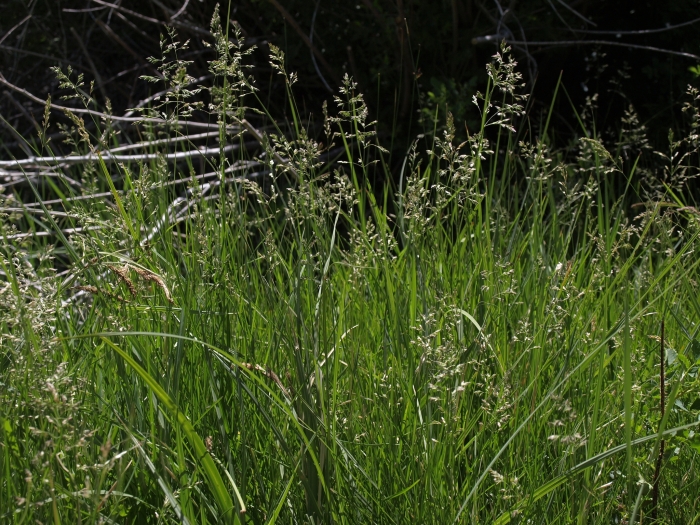Common Meadow Grass
(Poa pratensis)
Common Meadow Grass (Poa pratensis)
/
/

Jim Morefield
CC BY 4.0
Image By:
Jim Morefield
Recorded By:
Copyright:
CC BY 4.0
Copyright Notice:
Photo by: Jim Morefield | License Type: CC BY 4.0 | License URL: http://creativecommons.org/licenses/by/4.0/ | Rights Holder: Jim Morefield | Publisher: iNaturalist | Date Created: 2018-06-18T14:01-07:00 |





































































Estimated Native Range
Summary
Poa pratensis, commonly known as Common Meadow Grass or Kentucky Bluegrass, is a deciduous perennial grass native to temperate Eurasia, including Europe, Central Asia, and East Asia. It is often found in meadows, pastures, and open grasslands, where it forms a dense sod. Kentucky Bluegrass typically grows to a height of 60 to 90 cm (2 to 3 feet) when left unmowed, with a fine-textured, deep green foliage that forms an excellent turf. The flower heads are a bluish-purple color when they bloom from May to July, adding a subtle color to the landscape. Its ability to spread by rhizomes makes it a popular choice for lawns, sports fields, and parks due to its durability and self-repairing nature.
Kentucky Bluegrass is valued for its cold tolerance and ability to create a lush, durable lawn. It is widely used in temperate climates for its attractive appearance and ease of maintenance. This grass prefers well-drained, fertile soil and thrives in full sun to part shade. It requires medium amounts of water and can tolerate a range of soil drainage conditions. However, it can become invasive outside its native range, spreading into natural habitats and outcompeting native species. It is also susceptible to diseases such as leaf spot and rust, especially in humid conditions.CC BY-SA 4.0
Kentucky Bluegrass is valued for its cold tolerance and ability to create a lush, durable lawn. It is widely used in temperate climates for its attractive appearance and ease of maintenance. This grass prefers well-drained, fertile soil and thrives in full sun to part shade. It requires medium amounts of water and can tolerate a range of soil drainage conditions. However, it can become invasive outside its native range, spreading into natural habitats and outcompeting native species. It is also susceptible to diseases such as leaf spot and rust, especially in humid conditions.CC BY-SA 4.0
Plant Description
- Plant Type: Grass
- Height: 0.5-3 feet
- Width: 0.083-0.5 feet
- Growth Rate: Moderate
- Flower Color: N/A
- Flowering Season: Spring
- Leaf Retention: Semi-deciduous
Growth Requirements
- Sun: Full Sun, Part Shade
- Water: Medium
- Drainage: Medium
Common Uses
Bird Garden, Butterfly Garden, Fire Resistant, Groundcover, Low Maintenance
Natural Habitat
Temperate Eurasia, including meadows, pastures, and open grasslands
Other Names
Common Names: Common Meadow-Grass , Eng-Rapgræs , Kollektiv Art , Wiesenrispengras , Gewöhnliches Wiesen-Rispengras , Pâturin Des Prés , Foin À Vaches , Veldbeemdgras , Ängsgröe , 왕포아풀
Scientific Names: Poa pratensis , Poa florida , Poa reptans , Poa pratensis subsp. latifolia , Poa agassizensis , Poa pratensis subsp. agassizensis , Poa angustiglumis , Poa sergievskajae , Poa pratensis var. anceps , Poa pachyantha
GBIF Accepted Name: Poa pratensis L.